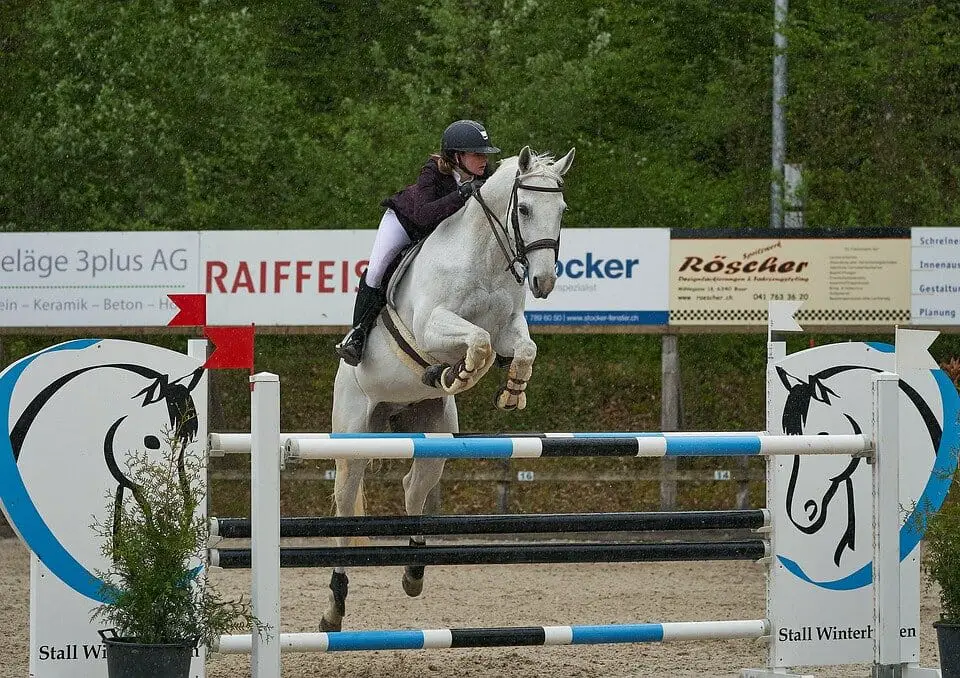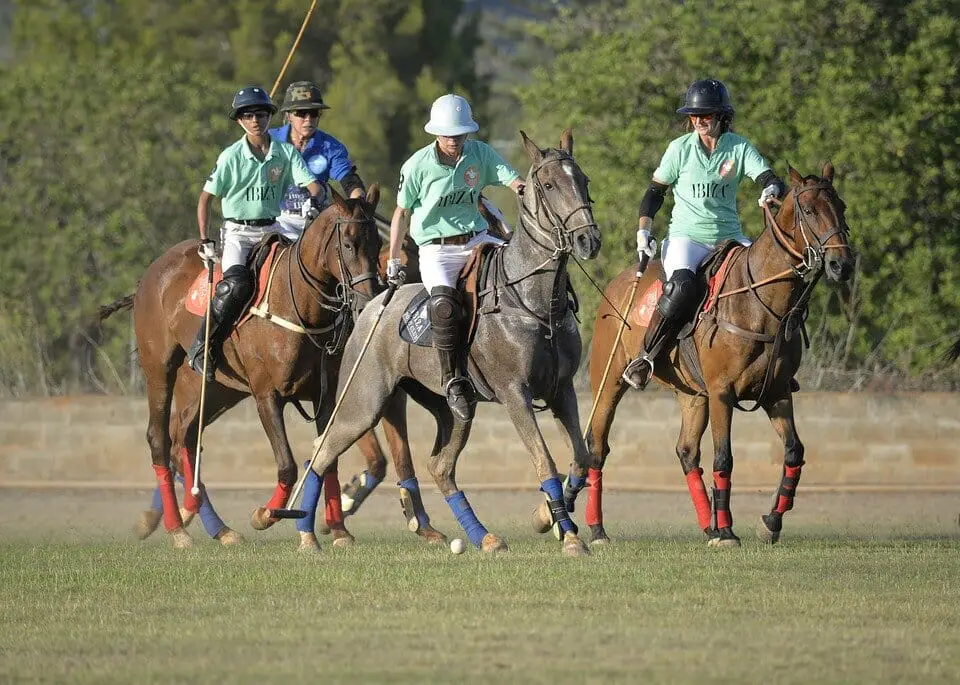A guest post by Lucy from Horse Fact Book.
If you’ve just started learning to ride or are at the stage where you’re thinking about trying different disciplines it can be daunting getting to know what they’re all about. This is why I thought I’d write this guide to the different types of English riding.
Dressage

Dressage is a very graceful and elegant discipline, often looking effortless, and is sometimes referred to as horse ballet. The word dressage is thought to be a corruption of the French word for training which describes this sport extremely well.
The ultimate goal for any dressage rider is to display how well the horse has been trained as well as to develop the communication they have with the horse.
Each level of dressage involves a series of tests that assess how well the horse and rider work together. The tests include a sequence of maneuvers designed to evaluate the horse’s natural athletic ability and put the pair’s communication to the test.
Each maneuver must be carried out with little or no visual communication. The idea is that the horse is trained well enough to respond to the slightest of commands.
Dressage is one of the three main English disciplines that the FEI (The Fédération Équestre Internationale is the governing body for equestrian sports) recognize as an Olympic sport.
Jumping
Jumping is a broad term used to describe a number of different sports that all focus on jumping.
Most people mistakenly think that jumping and show jumping are the same thing.
While show jumping is the most popular form of jumping, especially when on the international scene, it’s just one form of jumping with hunter jumper, equitation and cross-country being other types of jumping.
Regardless of the type of jumping the principle is the same and involves jumping a series of fences or obstacles.
Show Jumping

Show jumping normally takes place in an arena with a series of fences (known as a round) that the horse and rider have to clear (jump without knocking any down or the horse refusing to jump).
Each rider will take it, in turn, to clear the round as quickly as they can, with each rider failing to do so being eliminated until there is one winner.
Like dressage, show jumping is recognized by the FEI as an Olympic sport.
Hunter Jumper

Also called working hunter or show hunter. Hunt seat originated from the English and Irish pastime of fox hunting and is very similar to show jumping although time isn’t the most important aspect, nor is the ability to clear the round.
Unlike showjumping, judging for show hunter is focused on the horse. How well they jump with accuracy, finesse, and elegance as some of the most important factors.
A good hunter-jumper should also have a nice presence and a smooth, steady manner.
Equitation

Sometimes referred to as hunt seat, equitation is judged solely on the rider rather than the horse and is sometimes said to be the rider equivalent of hunter jumping! While it’s obviously the goal of the rider to clear the round it won’t effect the overall score, what is more important is the rider’s position.
Each judge will judge the rider slightly differently (there’s no global standard for judging equitation) but the judges are looking for how courageous the rider is in the choices they make but also how they ride the course – do they make it look easy or can you tell that they working hard to get round?
While equitation is based 100% on the rider’s performance it’s worth noting that the horse can, and does, contribute to how good or bad a rider can look.
Cross-Country Jumping

Cross-country events take place over an outdoor course with either natural fences, those that are made to look natural, or a mixture of both.
Like, show jumping the goal is to clear the course as quickly as possible. However in cross-country jumping sometimes there may be more than one route over some fences.
The quickest route is always the most challenging to jump with the easiest route takes the most amount of time. Unlike other forms of jumping, in cross country the jumps are solid so won’t fall if the horse knocks them.
This adds a level of danger to the sport and emphasizes the importance of jumping the fences well.
Eventing

Sometimes referred to as Horse Trails,eventing is a series of three different disciplines, dressage, cross-country and show jumping.
The original idea of eventing was as a cavalry test. It is designed to allow riders to demonstrate their skills at a variety of disciplines.
Eventing competitions can vary in length from one, two or three days and can be likened to a Triathalon with the scores of each discipline being combined to give an overall score.
As well as testing the rider, eventing is also a great test of a horse’s versatility and as such is said to be the ultimate test of horse and rider.
The perfect eventing horse is a combination of both a dressage horse as well as a good jumping horse.
Eventing, like both show jumping and dressage, is an Olympic sport and all three are among the very few Olympic sports that are considered equal with no gender-specific classes or events.
Saddle Seat

More popular in North America than it is in Europe, saddle seat is a very elegant style of riding that shows off the high knee actions of gaited horses such as the Tennessee Walker and American Saddlebred.
A classical style of riding, it originated from the plantations of the Southern United States where the owners wanted a comfortable way to ride around their vast estates.
There are a number of different classes included with saddle seat that are often limited to particular breeds. Each class will also have its own gait (or pace) requirements, for example:
Three-Gaited
Exclusive to American Saddlebreds, the gaits are limited to walk, trot and canter
Five-Gaited
Like the three-gaited classes its open to American Saddlebreds only and includes walk, trot and canter too but also the rack (a fast gait with a very showy knee action) and slow gait (sometimes called a running walk that’s a bit like a fast trot).
Plantation Walker
Solely for Tennessee Walkers that display a flat walk (a faster walk that gives the impression the horse is gliding over the ground), running walk and canter.
Park
Open to American Saddlebreds, Arabians and Morgans, the horses are judges on their knee action at walk, trot and canter.
Pleasure / Classic
Both of these classes are open to all breeds with the horse being judges on their smooth action at walk, trot, and canter.
Side Saddle

I know that technically side saddle is a way of riding rather than a specific discipline, after all, there’s nothing to stop you jumping or doing dressage while riding side saddle. That said, it does have its origins in English riding which is why I decided to include it in this article.
Anybody can ride side saddle but it’s more common for women to do so, it was, in fact, developed as a way for women to ride because it was thought at the time that it was inappropriate for them to straddle a horse.
It’s thought that the art of riding side saddle was developed during the 14th century (with Anne of Bohemia being the First Lady to ride side-saddle) and while this may have been the case for riding it certainly isn’t when the first side saddle was used.
Ancient Greek vases, as well as Celtic stone carvings, show women sitting side-saddle behind men.
Side saddle isn’t exclusive to English riding and is becoming more popular within the Western riding fraternity but its heritage is most definitely more closely linked with English riding.
Other English disciplines
Outside of the main disciplines mentioned above there are also a number that can, and do, fall within the umbrella of English riding.
Endurance

While endurance riding is popular as both an English and a Western sport, it’s more popular as an English style of riding at an International level.
As you can probably tell endurance riding is a test of endurance and stamina, not just of the horse, but the rider too. Endurance competitions range in distance, although they cover more than 160km (99 miles) in a single day.
Racing

You might not think of racing as belonging to any particular discipline but it is very much an English discipline and has its heritage in Great Britain where the Thoroughbred horse was first developed.
Racing saddles are extremely lightweight and are little more than a single piece of leather for the jockey to sit on.
There are two types of racing, flat or steeplechase which is over fences. The name steeplechase comes from the fact that the races used to be run between two church steeples.
Fox Hunting

Fox hunting is an old-fashioned sport that originated in England and Ireland that has changed a lot since it’s heyday. Originally it involved a group of riders along with a pack of hounds chasing a fox across fields and over natural jumps.
Thankfully though, these days hunting animals with dogs is banned in most countries, although the sport itself is still very popular and is sometimes referred to as drag hunting.
The name drag comes for the modern ‘fox’ which is a runner who drags a sack, which has been soaked in strong smells such as aniseed and paraffin, behind them. The hounds then follow that scent.
Polo

A team sport involving two teams of four riders, the idea of polo is to score a goal by knocking a small hard ball (with a long-handled wooden mallet) through the opposition’s goal.
Each match can last from one to two hours and is split in a series of four sessions known as chukkas, each of which are seven and a half minutes long.
Polo is one of the oldest equestrian sports and can be traced back to around 250BC.
-Lucy from Horse Fact Book


